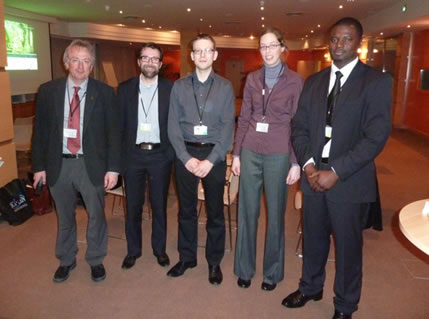
An Mariën wins BNS Thesis Competition for her research into oxygen sensors
SCK•CEN (Belgium) scientist An Mariën has won the Belgium Nuclear Society’s (BNS) Thesis Competition, for her investigation into electrochemical sensors that measure the oxygen concentration in lead-bismuth at very low temperatures.
BNS selected three short-listed candidates from among eight entries: Philippe Dejardin (BNEN), An Mariën (BNEN) and John Mitchel Onana Obama (ULB). On 1 March, they presented their theses at a BNS Evening Lecture, in Brussels.
The jury, which was made up of Eric van Walle (BNS Chairman) and 2 members of the BNS Young Generation, selected An Mariën’s thesis as the winner. She will receive € 1,250. As far as the public was concerned, all those present voted for the best presentation. Philippe Dejardin won this prize and received a bottle of champagne and a Bongo-bon gift voucher.

From left to right: Eric van Walle (BNS chairman), Hans Naômé (BNS-YG chairman), Philippe Dejardin (BNEN), An Mariën (BNEN) and John Mitchel Onana Obama (ULB).
An Mariën talks about her research into oxygen sensors
An: "As a component of the BNEN Master of Science in Nuclear Engineering curriculum, I wrote a thesis about electrochemical oxygen sensors to measure the oxygen concentration in lead-bismuth eutectic (LBE) at temperatures below 400 °C. The development of these sensors is important for the chemical conditioning of the LBE cooling agent in MYRRHA.
Most oxygen sensors that are currently used provide an unreliable result at very low temperatures. The low conductivity of the materials in the sensor could be a possible explanation for this unreliability. This is why I examined sensors that are made of materials with a better conductivity.
I carried out various characterisation studies (with X-ray diffraction, optical and scanning electron microscopy, 4-point conductivity measurements and bending tests) in order to check whether the studied materials complied with the requirements. The sensors were then tested in liquid metals at low temperatures (from -280 to -400 °C).
The results show that the use of more conductive materials does not result in a lower operating temperature of the sensors. This may indicate that the transfer of oxygen between the liquid metal and the sensor is not fast enough to obtain a reliable reading at low temperatures. Further research is therefore required in order to develop adequate oxygen sensors for the MYRRHA cooling agent.
I carried out my thesis with the help of Jun Lim and Kris Rosseel as mentors, and Peter Baeten as promoter. They provided me with excellent support during my research. I could also count on the technical support of many colleagues within the Onderzoek Nucleaire Systemen (ANS – Nuclear Systems Research) and Microstructurele en Niet-destructieve Analyse (NMS – Microstructural and Non-destructive Analysis) units. I would like to thank everybody for their contributions."
The 3 short-listed candidates and the title of their theses
-
An Mariën: Development and calibration of electrochemical oxygen sensors for application in low temperature regions in liquid lead alloys cooled reactors.
-
Philippe Dejardin: Current knowledge of the Molten Corium Concrete Interactions (MCCI) and parameters of importance for representative reactor cases under dry conditions using the MEDICIS code.
-
John Mitchel Onana Obama: Contribution to a risk-informed assessment of the technical specifications of a nuclear power plant.
|

